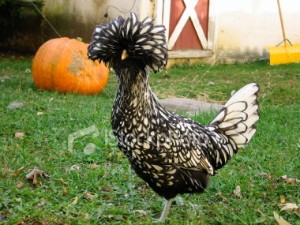There is little known about the origination of the Polish, except that it is one of the oldest breeds of chicken. However, it is known that the Polish chicken was depicted in paintings of the fifteenth century, and mentioned as a pure breed in writings in Europe as early as the sixteenth century. Archaeological evidence has also been found proving that crested breeds existed as far back as Roman times.
Perfection, if not origination, of the breed is believed to have been in Holland, but there are strong indications that both Spain and Italy were involved as well in development of the breed, as we know it today. The first Polish arrived in the United States in the mid seventeenth century, from England. The American Poultry Association first admitted the Polish in 1874, in the Continental Class. The APA’s Standard of Perfection consists of four varieties being admitted in 1874, four more in 1883, one variety in 1938, 1963 and 1996. The name “Polish” is more than likely due to the poll, the bony structure on the head, giving rise to the crest, a puff of feathers on the head. Charles Darwin classified all races of fowl with topknots as “Crested or Polish”, although he gave no data as to the origination of the breed we know as the Polish.
QUALITIES and ATTRIBUTES
Polish chickens come in a variety of colors, and both bearded and non bearded. The American Poultry Association recognizes the Black Crested White, White Crested Black, White Crested Blue, Silver, Golden, White and Buff Laced varieties. Other colors and patterns not recognized, but being worked on by organizations such as the Polish Breeders Club, include laced and spangled, chocolate, mottled, splash, crele, cuckoo, red and more.
The Polish legs and feet are smooth and a slate or blue color. Some varieties have beards and muffs, with small wattles. The non bearded varieties have larger wattles. The v-shaped comb should be small, and set evenly on head, retreating into the crest. According to the APA’s Standard of Perfection, the smaller the comb, the better, and in fact the natural absence of crest is preferred. The nostrils are large, wide and cavernous that is found only in crested breeds. The male’s crest should be very large and free from any split or part, and the females should be small, compact and globular shaped. The crests, also known as topknots make male and females easily distinguishable, even from a distance.
This breed is available in both standard and bantam sizes. Mature standard sized roosters should weigh 6 pounds, and hens 4 1/2 pounds. Bantam roosters should weigh 30 ounces and hens 26 ounces. The Polish are considered an ornamental breed, kept mainly by fanciers, but since they lay about 200 medium-to-large white eggs, per year, they make a fine backyard chicken. These chickens are very friendly and calm, making them excellent pets, especially for children. They are very entertaining to watch, always strutting their beautiful crests and flowing tail feathers. Due to their impressive crests, their vision can be restricted, so an enclosed coop/run and only allowing them out with close supervision is a must for their protection. Although they can be a bit flighty, they do tolerate confinement well.
If you enjoyed this article, want to know more about this or other related interesting topics, please like and share this article. Be sure to like us, so you don’t miss anything, we are Sweet Basil Farm & Gardens on Facebook. We breed sell and ship poultry, pet pigs, bearded irises and much more. We have an 80 acre working farm, with great emphasis on all natural gardening and livestock management practices. We are blessed to have an 1840s General Store on our property which serves as our own site farmer’s market. Conveniently located on Johnstonville Rd., in Barnesville, Georgia, right off of I-75.
Special thanks to the American Standard of Perfection by the American Poultry Association, The Chicken Encyclopedia by Gail Damerow, Storey’s Illustrated Guide to Poultry Breeds by Carol Ekarius, for helpful information and contributions from David Matthews, of Barnesville, Georgia in preparation of this article. Photo credits to Wikipedia.

No comments:
Post a Comment